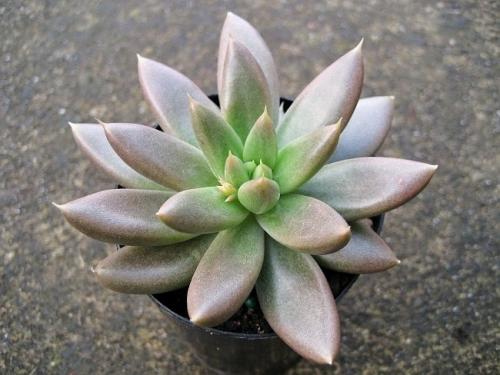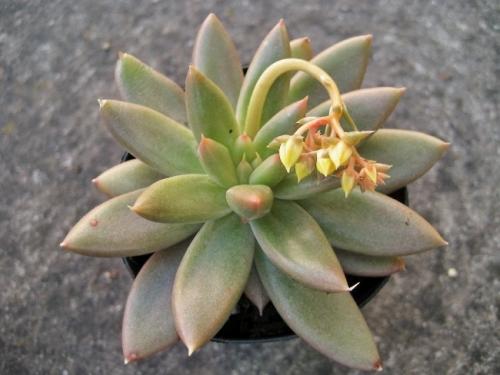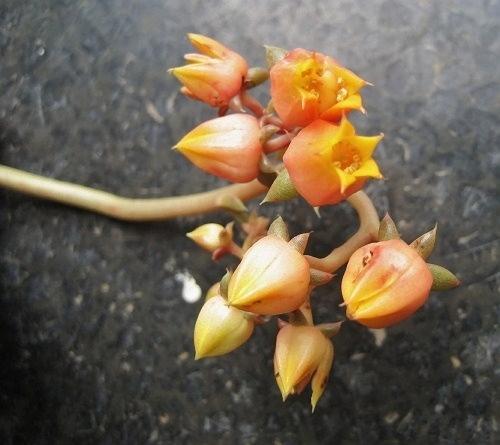TOLIMANENSIS Matuda, 1958
Synonym : Echeveria cuspidata J.A. Purpus non Rose (1907) (Ixmiquilpan)
Series Urbiniae
Type : Matuda 32637. México : Estado de Hidalgo en rocas paradas de la Barranca de Tolimán a 1900 – 2000 m; Marzo 23 de 1955.
Etymology : Named for the type locality Barranca de Tolimán.
Distribution : Mexico (Hidalgo, Queretaro, Tamaulipas).
First Description by Matuda in Cactáceas y Suculentas Mexicanas 3(2):31. 1958 :
Planta acaulescente, muy parecida a Pachyphytum, por sus hojas carnosas y pruinosas.
Hojas 15 – 25, densamente rosetadas, sésiles, carnosas, oblongas, acutinadas a espiniformes, con las bases semisueltas, semicóncavas, finalmente pruinosas, de 4 – 8.5 cm de largo, por 2 – 2.5 cm de ancho y 1 – 1.5 cm de grosor.
Inflorescencia lateral ascendente, flojamente paniculada con escapo cilindrico carnoso, glabro, de color rosado, algo pruinosos, de 20 – 25 cm de largo.
Flores pedunculadas; pedúnculo de color rosado, rollizo, colgante en el principio, ascendente en el tiempo de floración, de 1.5 – 2 cm de largo.
Cáliz de 5 cm partido con las partes lineal triangulares, canaliculados, reflejados de 5 – 7 mm de largo.
Corola gamopétala, de color amarillo-anaranjado, con tubo semicilindrico, de 4 mm de largo por 5 mm de grosor; limbo de 5-lobo, poco reflejados; lobos oblongos acuminados de 6 – 7 mm de largo por 2 – 3 mm de ancho; estambres 10, insertados en el tubo de la corola e incluidos.
Cytologie : n = 30
A more detailed description by Reid Moran (of M 10044) :
Plant glabrous.
Caudex 1 - 2.5 cm thick, rarely 5 cm tall, mostly unbranched.
Rosettes solitary, 10 - 20 cm wide, of 20 - 50 crowded leaves.
Rosette leaves dark green to yellowish green or somewhat purplish or lavender, at first farinose, elliptic to oblanceolate, acute and long-apiculate, 5 - 9 cm long, 12 - 22 mm wide, 7 - 12 mm thick, rounded dorsally, slightly concave to slightly convex ventrally, the margins rounded, the apiculus 2 -4 mm long, the base with one subventral main vascular strand and ca 4 - 5 smaller strands in an arc below.
Floral stems 1 - 2.5 dm tall (to the inflorescence), 3 - 6 mm thick, pale green or pink above, not glaucous, naked in the lower 1 - 13 cm, with 7 - 15 leaves equally distributed above.
Stem leaves elliptic, acute and apiculate, spurred, attached ventrally and outcurved, 10 - 16 mm long, 1.5 - 4 mm wide, 1 - 2.5 mm thick, convex dorsally and ventrally, the margins subacute to rounded, the spur whitish, truncate to acute or sometimes two-toothed.
Inflorescence at first reflexed, of two cincinni each to 10 cm or more long and with 3 - 15 flowers.
Lower pedicels 9 - 17 mm long, 1 - 1.5 mm thick, thicker upward.
Calyx disk 4 - 5 mm wide, the lobes somewhat reflexed, apiculate, unequal, the larger triangular-lanceolate, 7 - 9 mm long, 3 - 4 mm wide, 1.5 - 2 mm thick, the smaller triangular, 3 - 6 mm long, 2 - 2.5 mm wide,.
Corolla 10 - 14 m long, 7 - 9 mm wide at the base, 5 - 7 mm wide just below the apex, 8 - 14 mm wide at the spreading tips, light orange (ca 9 F 8), more yellow towards the apex, circular in cross section at the base, the sides flattened above.
Petals connate 2 - 3 mm and adhering slightly, to 6 - 7 mm , triangular-lanceolate, acute, apiculate, 3.5 - 4 mm wide, obtusely keeled, with the sides flattened, ventrally yellow above and whitish below, slightly channeled, with no nectar pit though somewhat cupped at the base, the apiculus dorsal ca 0.6 - 0.8 mm long.
Filaments whitish below, yellowish above, extending to ca 6 - 8 mm from the corolla base, ca 0.6 - 0.7 mm wide at the base, adnate ca 3 mm; anthers light yellow or pinkish, oblong-lanceolate, ca 2.5 - 4 mm long and I mm wide. Nectal glands white, 1.3 - 2.3 mm wide, 0.6 mm high, the secretory surface parallel to the floral axis. Gynoecium 8 - 10 mm high, 4.5 - 6 mm thick, whitish below shading to light green above, the pistils connate, 1 - 2 mm, the ovaries 5 - 6.5 mm high, the styles slender, 2.5. - 3.5 mm long, ovules 150 - 350, cylindric, ca 0.7 mm long and 0.2 mm thick.
Chromosomes : n = 30
Note :
E. Walther's description of E. tolimanensis (Echeveria, p. 87-88, 1972) is of a plant with unknown origin and not from a plant of the type locality. It is of no use. Accordingly also Kimnach's summary of Walther's description in the Illustrated Handbook of Succulent Plants, 2003, is of no use.
Plants in habitat in Hidalgo, Mexico :
Plantes dans l'habitat de l'Hidalgo, Mexique :
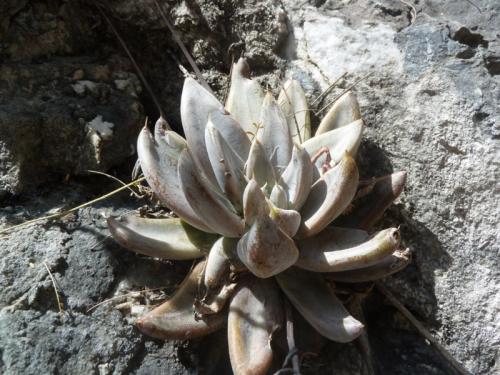
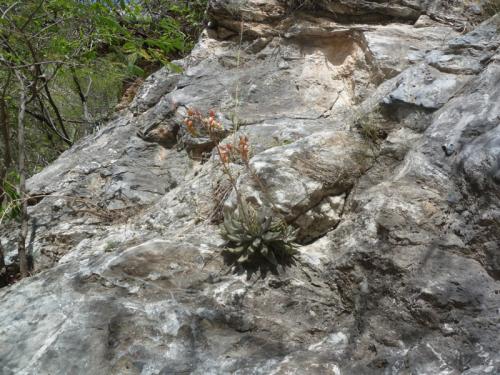
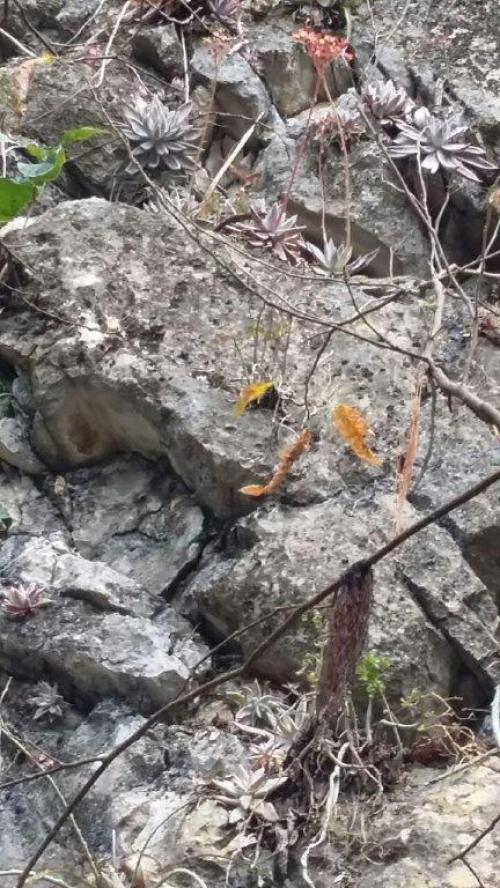
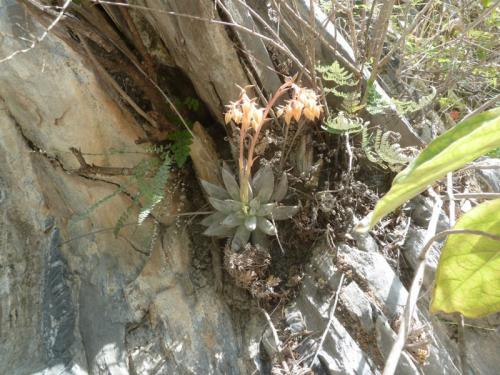
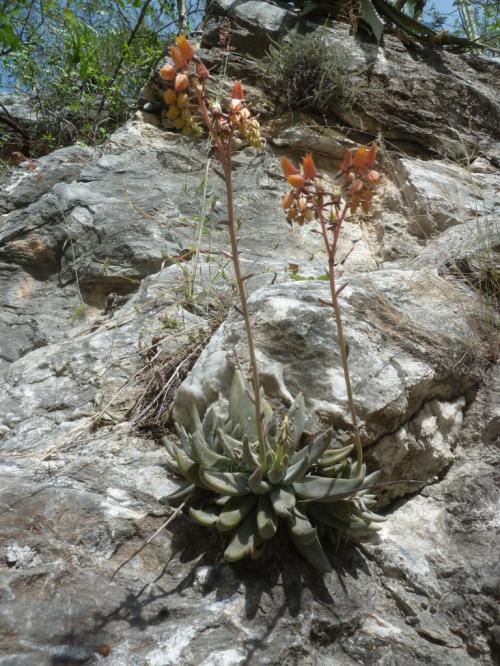
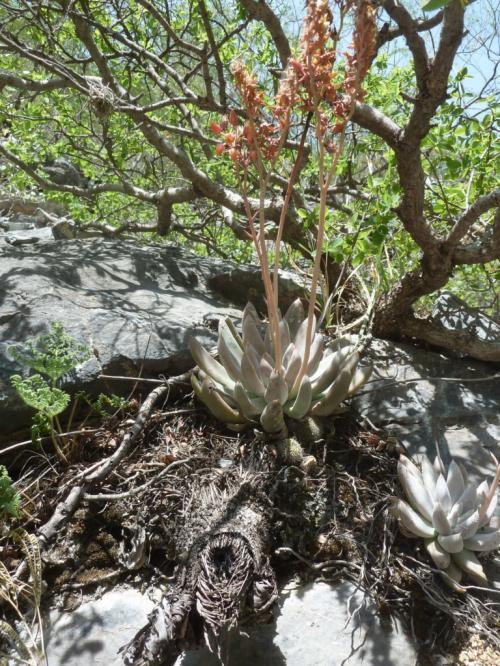
Photos Gerhard Köhres
Plants in cultivation / Plantes en culture :
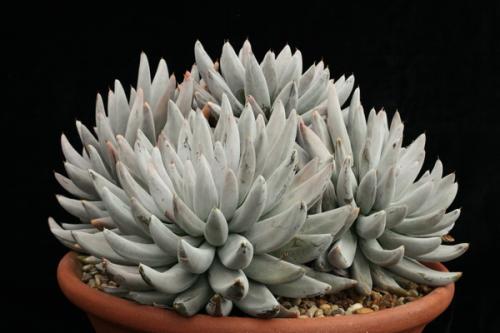
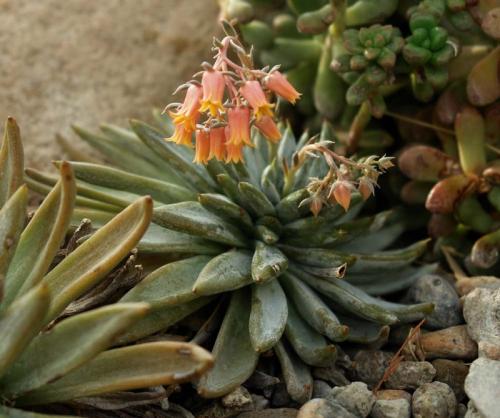
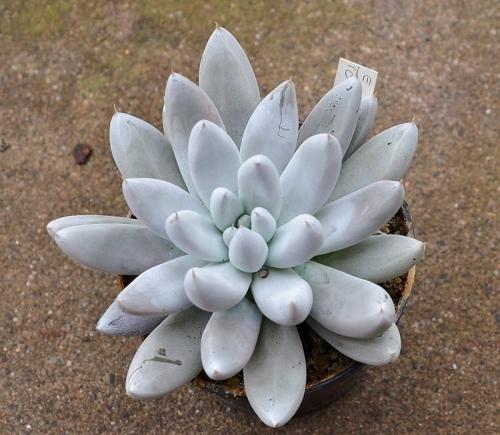
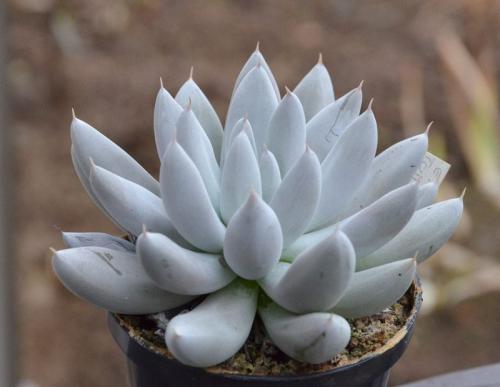
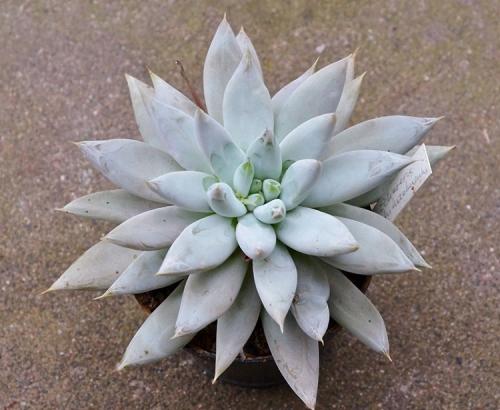
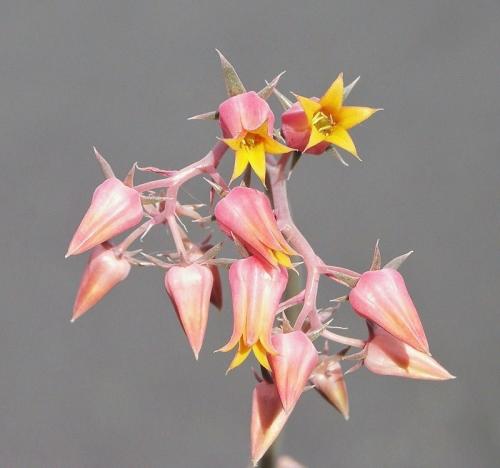
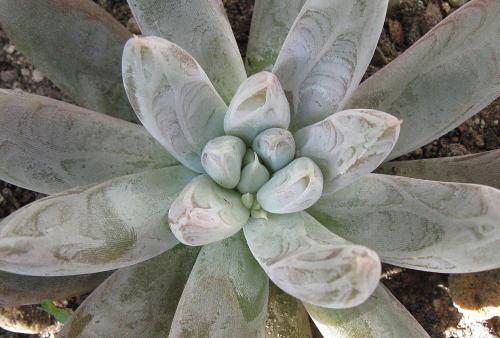
Photo Jacquie Koutsoudis
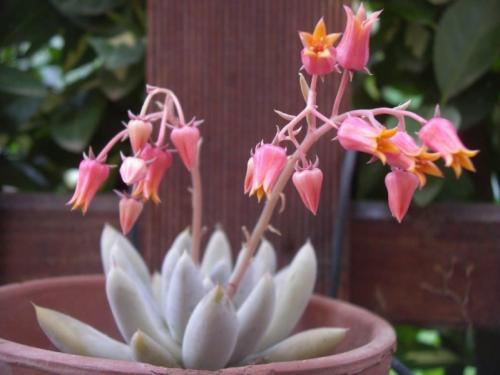
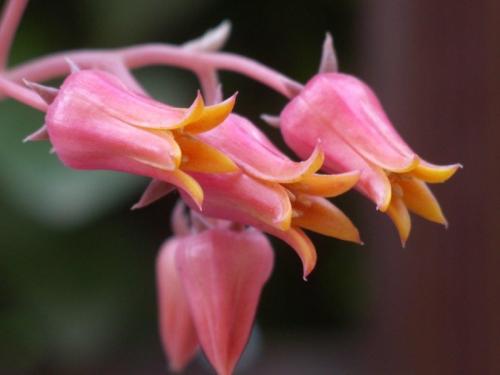
Photos Mateo Lichtenstein
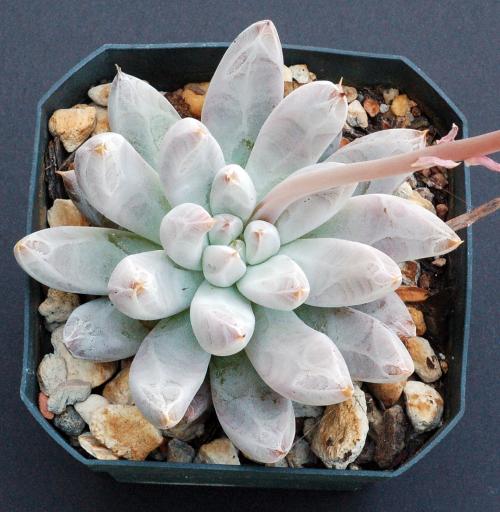
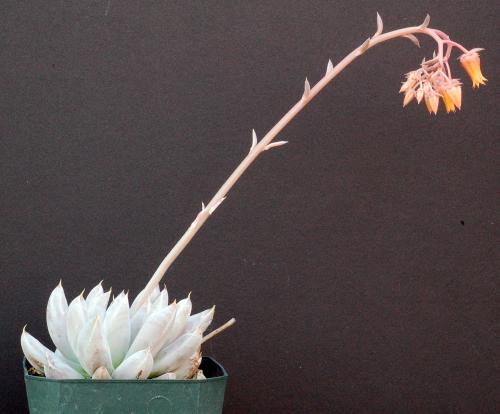
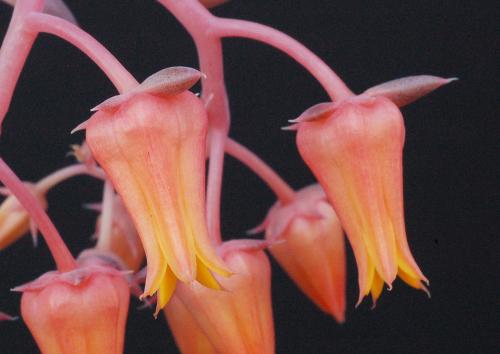
Photos Bernie DeChant
There is also a form with not pruinose leaves, its origin is unknown :
Il existe aussi une forme à feuilles sans pruine, son origine est inconnue :
